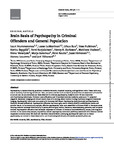Brain Basis of Psychopathy in Criminal Offenders and General Population
| dc.contributor.author | Nummenmaa, L | |
| dc.contributor.author | Lukkarinen, L | |
| dc.contributor.author | Sun, L | |
| dc.contributor.author | Putkinen, V | |
| dc.contributor.author | Seppälä, K | |
| dc.contributor.author | Karjalainen, T | |
| dc.contributor.author | Karlsson, HK | |
| dc.contributor.author | Hudson, Matthew | |
| dc.contributor.author | Venetjoki, N | |
| dc.contributor.author | Salomaa, M | |
| dc.contributor.author | Rautio, P | |
| dc.contributor.author | Hirvonen, J | |
| dc.contributor.author | Lauerma, H | |
| dc.contributor.author | Tiihonen, J | |
| dc.date.accessioned | 2021-08-20T16:36:07Z | |
| dc.date.available | 2021-08-20T16:36:07Z | |
| dc.date.issued | 2021-09 | |
| dc.identifier.issn | 1047-3211 | |
| dc.identifier.issn | 1460-2199 | |
| dc.identifier.uri | http://hdl.handle.net/10026.1/17625 | |
| dc.description.abstract |
Psychopathy is characterized by persistent antisocial behavior, impaired empathy, and egotistical traits. These traits vary also in normally functioning individuals. Here, we tested whether such antisocial personalities are associated with similar structural and neural alterations as those observed in criminal psychopathy. Subjects were 100 non-convicted well-functioning individuals, 19 violent male offenders, and 19 matched controls. Subjects underwent T1-weighted magnetic resonance imaging and viewed movie clips with varying violent content during functional magnetic resonance imaging. Psychopathic traits were evaluated with Levenson Self-Report Psychopathy Scale (controls) and Psychopathy Checklist-Revised (offenders). Psychopathic offenders had lower gray matter density (GMD) in orbitofrontal cortex and anterior insula. In the community sample, affective psychopathy traits were associated with lower GMD in the same areas. Viewing violence increased brain activity in periaqueductal grey matter, thalamus, somatosensory, premotor, and temporal cortices. Psychopathic offenders had increased responses to violence in thalamus and orbitofrontal, insular, and cingulate cortices. In the community sample, impulsivity-related psychopathy traits were positively associated with violence-elicited responses in similar areas. We conclude that brain characteristics underlying psychopathic spectrum in violent psychopathy are related to those observed in well-functioning individuals with asocial personality features. | |
| dc.format.extent | 4104-4114 | |
| dc.format.medium | ||
| dc.language | en | |
| dc.language.iso | eng | |
| dc.publisher | Oxford University Press (OUP) | |
| dc.subject | empathy | |
| dc.subject | fMRI | |
| dc.subject | psychopathy | |
| dc.subject | VBM | |
| dc.subject | violence | |
| dc.title | Brain Basis of Psychopathy in Criminal Offenders and General Population | |
| dc.type | journal-article | |
| dc.type | Journal Article | |
| dc.type | Research Support, Non-U.S. Gov't | |
| plymouth.author-url | https://www.webofscience.com/api/gateway?GWVersion=2&SrcApp=PARTNER_APP&SrcAuth=LinksAMR&KeyUT=WOS:000741349100010&DestLinkType=FullRecord&DestApp=ALL_WOS&UsrCustomerID=11bb513d99f797142bcfeffcc58ea008 | |
| plymouth.issue | 9 | |
| plymouth.volume | 31 | |
| plymouth.publication-status | Published online | |
| plymouth.journal | Cerebral Cortex | |
| dc.identifier.doi | 10.1093/cercor/bhab072 | |
| plymouth.organisational-group | /Plymouth | |
| plymouth.organisational-group | /Plymouth/Faculty of Health | |
| plymouth.organisational-group | /Plymouth/Faculty of Health/School of Psychology | |
| plymouth.organisational-group | /Plymouth/REF 2021 Researchers by UoA | |
| plymouth.organisational-group | /Plymouth/REF 2021 Researchers by UoA/UoA04 Psychology, Psychiatry and Neuroscience | |
| plymouth.organisational-group | /Plymouth/Users by role | |
| plymouth.organisational-group | /Plymouth/Users by role/Academics | |
| dc.publisher.place | United States | |
| dcterms.dateAccepted | 2021-03-06 | |
| dc.rights.embargodate | 2023-8-5 | |
| dc.identifier.eissn | 1460-2199 | |
| dc.rights.embargoperiod | Not known | |
| rioxxterms.versionofrecord | 10.1093/cercor/bhab072 | |
| rioxxterms.licenseref.uri | http://www.rioxx.net/licenses/all-rights-reserved | |
| rioxxterms.licenseref.startdate | 2021-07-29 | |
| rioxxterms.type | Journal Article/Review |


